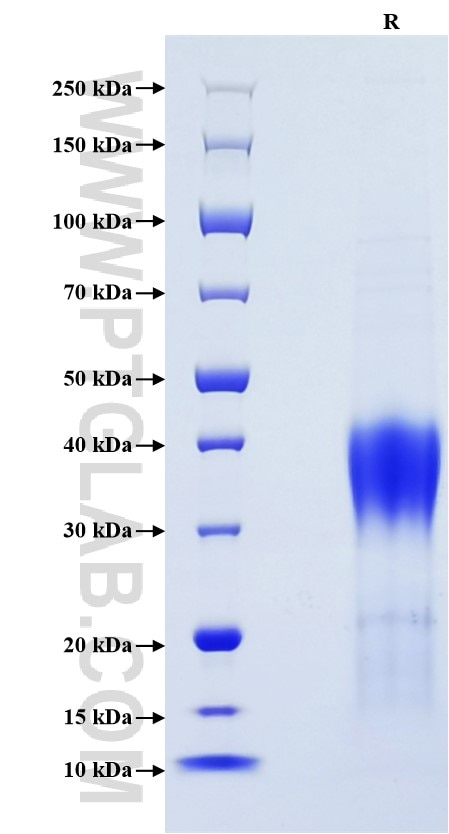Recombinant Human CD28 protein (His Tag)
Species
Human
Purity
>90 %, SDS-PAGE
Tag
His Tag
Activity
not tested
Cat no : Eg0889
Validation Data Gallery
Product Information
| Purity | >90 %, SDS-PAGE |
| Endotoxin | <0.1 EU/μg protein, LAL method |
| Activity |
Not tested |
| Expression | HEK293-derived Human CD28 protein Asn19-Pro152 (Accession# P10747-1) with a His tag at the C-terminus. |
| GeneID | 940 |
| Accession | P10747-1 |
| PredictedSize | 16.2 kDa |
| SDS-PAGE | 30-40 kDa, reducing (R) conditions |
| Formulation | Lyophilized from 0.22 μm filtered solution in PBS, pH 7.4. Normally 5% trehalose and 5% mannitol are added as protectants before lyophilization. |
| Reconstitution | Briefly centrifuge the tube before opening. Reconstitute at 0.1-0.5 mg/mL in sterile water. |
| Storage Conditions |
It is recommended that the protein be aliquoted for optimal storage. Avoid repeated freeze-thaw cycles.
|
| Shipping | The product is shipped at ambient temperature. Upon receipt, store it immediately at the recommended temperature. |
Background
CD28 (T-cell-specific surface glycoprotein CD28), or T44 and Tp44, is a member of the immunoglobulin superfamily and is expressed on most T lineage cells, NK cell subsets, and plasma cells. CD28 may affect in vivo immune responses as a cell adhesion molecule linking B and T lymphocytes and as the surface component of a novel signal transduction pathway. CD28 binds both CD80 and CD86 with a highly conserved motif MYPPY in the CDR3-like loop. In addition, CD28 is considered a major co-stimulatory molecule, inducing T lymphocyte activation and IL-2 synthesis, and preventing cell death.
References:
1. C H June. et al. (1990). Immunol Today. 11(6):211-216. 2. P S Linsley. et al. (1993). Annu Rev Immunol. 11:191-212. 3. Edward J Evans. et al. (2005). Nat Immunol. 6(3):271-279. 4. W Lesslauer. et al. (1986). Eur J Immunol. 16(10):1289-1296 5. R J Peach. et al. (1994). J Exp Med. 180(6):2049-2058.

